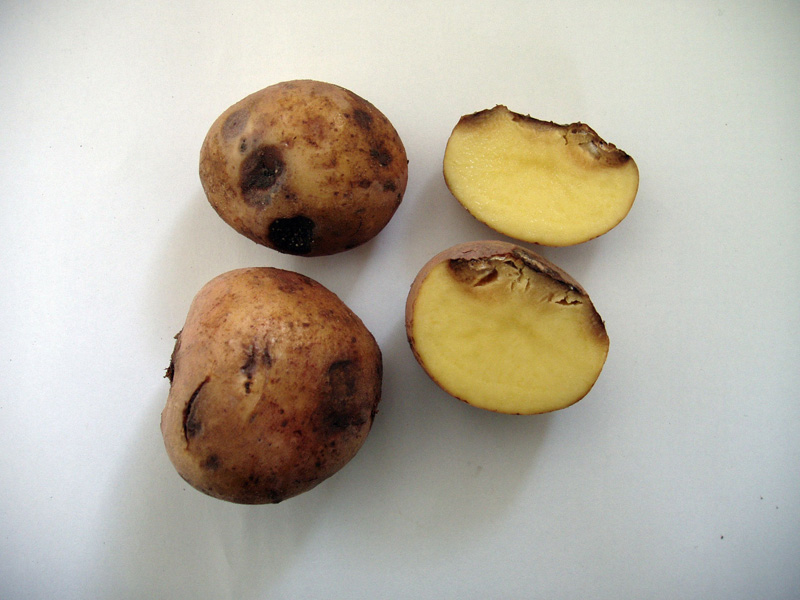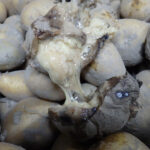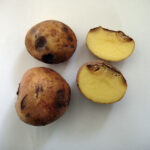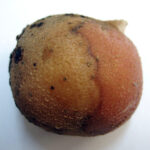Polish name: Mokra zgnilizna bulw
English name: Bacterial Soft Rot
EPPO code: ERWIAT, ERWICA, ERWICH
Perpetrators of the disease:
- bacteria of the genus Pectobacterium, most often the species P. atrosepticum (syn. Erwinia carotovora subsp. atroseptica), EPPO code: ERWIAT
P. carotovorum subsp. carotovorum (syn. Erwinia carotovora subsp. carotovora), EPPO code: ERWICA
bacteria of the genus Dickeya spp., EPPO code: ERWICH
Gallery

Wet rot. Symptoms of wet rot on the surface of the tubers
(fot. J. Osowski)
- Mokra zgnilizna. Zniszczone tkanki wewnętrzne bulw ziemniaka przez sprawców mokrej zgnilizny (fot. J. Osowski)
- Mokra zgnilizna. Objawy mokrej zgnilizny na powierzchni bulw (fot. J. Osowski)
- Mokra zgnilizna. Pierwsze objawy mokrej zgnilizny na bulwach ziemniaka (fot. J. Osowski)
Characteristics and description of the disease
Mokra zgnilizna występująca na bulwach ziemniaka w następstwie rozwoju czarnej nóżki na plantacji powoduje niekiedy znaczne straty gospodarcze. Mokra zgnilizna to najpowszechniejsza z chorób bakteryjnych występujących na bulwach w okresie przechowywania. Bakterie te są bardzo rozpowszechnione w środowisku, zarówno w glebie, powietrzu i ciekach wodnych, jak i innych uprawach (np. marchew, buraki, niektóre chwasty).
The optimal temperature for bacterial growth is 21-24 ° C. Under favorable conditions, the entire process of tuber rotting can take only a few days. Wet rot can also develop at lower temperatures (even as low as 2-4 ° C). As the temperature rises, the disease progresses faster and faster.
The source of infection of young progeny tubers during the growing season can be both bacteria from infected seed potatoes and bacteria from plants infected with black leg. In the first case, the bacteria are released into the soil after diseased seed potatoes have broken down. At increased humidity, soils move in the soil particularly easily, being a source of infection of daughter tubers of neighboring plants. Bacteria on infected mother tubers can also migrate to the plant stems, causing blackleg symptoms.
The second source of infection is black-legged plants in the plantation, which are a direct source of infection, primarily for the tubers they produce. Bacteria are transferred to young tubers with conductive bundles through stolons. The tubers are contaminated with bacteria that settle primarily in the lenticels or on the surface of the skin. Bacteria that penetrate the tubers, e.g. during the growing season, may remain latent in them and never show up if the potatoes are stored under appropriate conditions. Only stress factors such as mechanical damage, “overheating” of tubers or excess moisture can reveal the disease.
An indirect factor contributing to the development of the disease are mechanical treatments – harvesting, sorting (contact of sick tubers with belts may cause infection of each healthy tuber which then passes through the conveyor belt), and mechanical destruction of the tops. The occurrence of wet rot is favored by mechanical damage to tubers during harvesting, transport and processing, as well as their infestation by other pathogens, e.g. potato blight.
During storage, the disease develops intensively on tubers stored in poor conditions (at elevated temperatures, in humid, poorly ventilated rooms). Wet tuber rot usually begins with spiracles, and under pathogen-friendly conditions (heat and high humidity), the entire tuber quickly turns into a soft, disintegrating, foul-smelling mass.
In storage, even a small outbreak of tubers with symptoms of wet rot can cause a lot of trouble and contribute to the massive infestation of others. Mucus leaks from diseased tubers, containing millions of bacteria, infect neighboring tubers. Bacteria penetrate healthy tubers even through slight damage to the skin or spiracles, i.e. natural holes in the skin. The contaminated tubers create new wet rot foci, leading to massive spread of the disease. Such wet rot outbreaks can lead to the collapse of the entire potato pile. Insects and arachnids play an important role in the transmission of bacteria in the storage room. In practice, all potato varieties are infested with wet rot bacteria.
Bacteria can also be found in visually healthy tubers in a latent (latent) form, mainly in lenticels. Under favorable conditions, the bacteria become active, multiply and start rotting tubers. Revealing the symptoms of the disease depends in this case especially on external conditions that have a huge impact on its development. The rot begins when a layer of water forms on the surface of the tuber and anaerobic conditions are created (favoring a decrease in the resistance of tuber tissues).
Serious tuber losses in professional potato storage facilities due to the development of wet rot are rare, except in cases where the tubers are very wet or ventilation is impeded or insufficient.
Symptoms of paralysis
Initially, the surface of the tubers shows moist spots resembling waterlogging (photo 1). Wet rot usually begins with spiracles. In these places, initially small depressions are formed (Fig. 2) filled with mucilaginous, creamy rotten tissue, with a very unpleasant odor. Tubers infected with bacteria darken and rot. All tissues, except the skin, are decomposed, as a result of which the entire flesh turns into a liquid, strongly foul-smelling mass (photo 3). The symptoms of the disease on tubers are closely related to the potato variety, temperature, soil and air humidity. For this reason, it is difficult to single out individual species based on disease symptoms. Laboratory tests should be performed to obtain an accurate answer for a specific bacterial species.
Distinctive diagnostic features assigned to specific bacterial species (although they are not completely unambiguous):
- the edges of the lesions are slightly marked, the rot has a gel-like consistency, rather odorless – Dickeya solani, Dickeya dianthicola
- the edges of the lesions are often clearly marked (black), the affected tissue has a spongy, rather odorless consistency – Pectobacterium atrosepticum, Pectobacterium carotovorum ssp. brasiliense
- the edges of the lesions are indistinctly marked, an unpleasant smell similar to the smell of decaying fish – Pectobacterium carotovorum spp. carotovorum
- Indistinctly marked rot, an unpleasant smell similar to the smell of spoilage fish, bubbles containing CO2 are formed when the tuber is pressed, tuber content usually leaks out – Pectobacterium wasabiae
Protection methods
Protection of tubers against wet rot is indirectly related to the protection of potato plantations against black leg, i.e. negative selection, i.e. the removal of diseased plants, including the mother tuber and young tubers. Direct protection of tubers against the development of wet rot consists in avoiding digging up the tubers in humid weather and at air temperatures below 8oC. Low temperatures favor the occurrence of mechanical damage. Tubers placed in storage should be dried, cleaned and sorted before storage. Potatoes should be stored in cool, dry and well ventilated places, and they should be controlled and outbreaks of disease removed.
In regions with a high risk of disease, an effective and cheap method of its reduction is the cultivation of varieties with increased resistance to bacterial causative pathogens.
Compiled by: prof. dr hab. Józef Kaps



